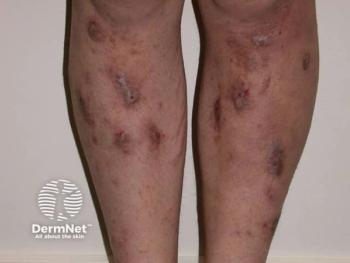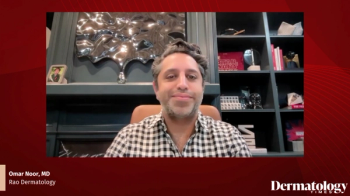
Protocol for injecting fillers gives more predictable results
Partitioning the face into different units and injecting filler in specific locations is a method to attaining a rejuvenated face that looks relaxed and natural.
Dividing the face into units before injecting any filler is an effective approach to rejuvenate and contour the face, according to Mauricio de Maio MD, a plastic surgeon based in Brazil.
Speaking here at the annual meeting of the Canadian Association of Aesthetic Medicine, Dr. de Maio explains the MD Codes™, a detailed plan that he has developed to guide injections in the face. The MD Codes highlight specific anatomical sites of the face and specific injection points in those anatomical sites.
"Aging is merciless," says Dr. de Maio, in an address to dermatologists, surgeons, and family physicians who focus on aesthetic medicine. "If you do not do anything, you will lose attractiveness. Sagginess can start even in the 30s."
Other key changes that occur with aging is overall volume loss in the face, hollowness in the tear trough that creates a tired look, volume loss at the corners of the mouth that creates a sad look, and a loss of soft tissue along the jawline.
Restoring volume with injection of filler is critical to creating desirable contours in the face, and proper use of fillers fights against the development of jowls and depressions in the lower face, which occur in part due to gravity, explains Dr. de Maio.
There have been advances in products and techniques in facial rejuvenation in the last two decades such that fillers are safer and rarely permanent and the objective of filler injection is about treating the whole face. "In the last century we used to inject fillers to chase lines (on the face)," notes Dr. de Maio.
Dividing areas of the face is a clear-cut strategy to achieve facial enhancement and rejuvenation, according to Dr. de Maio.
"The face is divided into subunits, and the location of injection should be precise," says Dr. de Maio.
Dr. de Maio divides the face into numerous points of injection that affect the temples, the forehead, the brows, the cheeks, the under eye area, the nasolabial area, the marionette lines, the jawline, the lips, and the chin.
Individuals age from lateral to medial and from up to down, a phenomenon that injectors need to recognize, notes Dr. de Maio. "When we look in the mirror, we hardly ever appreciate how we look tilted down," he says.
Overfilling the cheeks with filler, for example, creates a heavy appearance that will worsen the look of the nasolabial folds, according to Dr. de Maio.
Clinicians need to notice any particular features such as a recessed maxilla, for example, before injecting. They should also take note of the patient's age to assess if any features are a reflection of normal aging or are uncharacteristic of someone of a given age, according to Dr. de Maio.
"A downward oral commissure happens at age 50," says Dr. de Maio. "If it is already defined at age 25, that is an emergency (in aesthetic medicine)."
The type of product that is injected is also another consideration, says Dr. de Maio. "For the eyebags, we have to be careful not to produce a Tyndall effect or edema," says Dr. de Maio. "If you use a hydrophilic product, you can get a Tyndall effect or edema."
Dr. de Maio's approach involves treating an adjacent area, for instance the cheek, to produce a beneficial effect on another area, the tear trough, without performing direct injection into the tear trough. "Always treat the cheek first before treating the tear trough," says Dr. de Maio. "Provide support for the cheek, and only after that, address the tear trough area directly."
It is important that clinicians not commit to patients that they will be able to achieve all the outcomes that patients request. "Dark circles (under the eyes) are very challenging," he says. "I never promise that I will be able to correct the dark circles. Treating eye bags is one thing, but treating color is different."
The etiology of lower eyelid lines can often be deflation in the eye area, so injection can decrease the appearance of the lines, says Dr. de Maio. "Once deflation is corrected with volume, the lines were reduced," he says.
When it comes to lips, clinicians need to be cautious not to overfill the lips. "You want to achieve elegance," he says. "If you inflate too much, they (upper and lower lips) will look like sausages."
As an example, one ml of filler injected in the upper and lower lip, respectively, provides sufficient fullness of the lips, says Dr. de Maio.
No one tool can achieve facial rejuvenation, so both needles and cannulas should be used, and sometime a micro bolus is injected, says Dr. de Maio. Typically, cannulas should be used for large areas, and needles are a "perfect tool" when the injection needs to reach the bone, explains Dr. de Maio.
Injections should, as a rule, be performed slowly, and clinicians should aspirate and then inject, explains Dr. de Maio. Morever, injections should usually be of low volume. A fanning technique or linear technique can be employed depending on the desired impact.
"Whether the injection is deep to the bone, subcutaneous, or intravascular depends on the effect we want," says Dr. de Maio.
The effect of multiple filler injections in precise sites of the face can sustain up to one year and beyond, notes Dr. de Maio.
Disclosure: Dr. de Maio is a consultant and an advisory board member for Allergan. He has received honoraria for providing lectures on the company's behalf.
Newsletter
Like what you’re reading? Subscribe to Dermatology Times for weekly updates on therapies, innovations, and real-world practice tips.


















